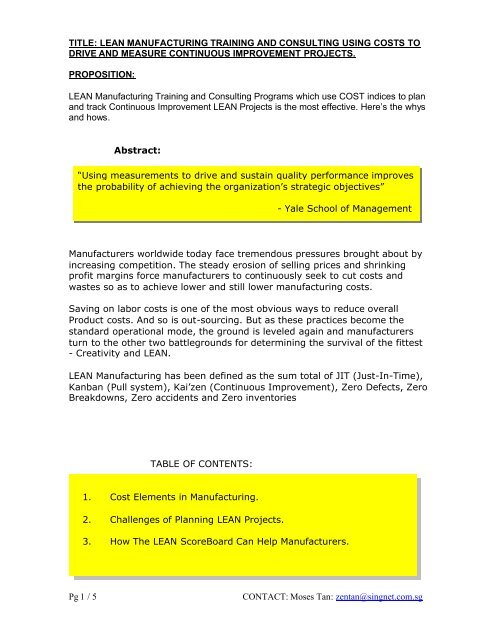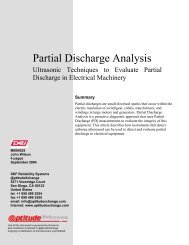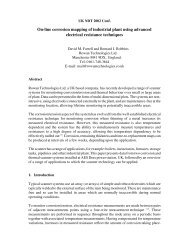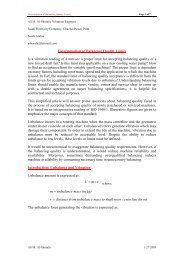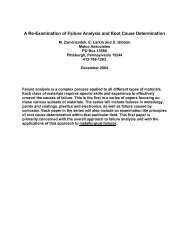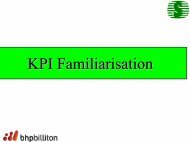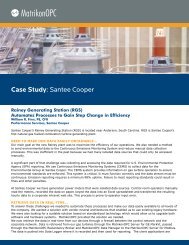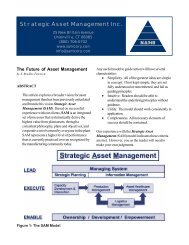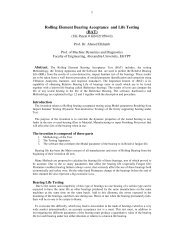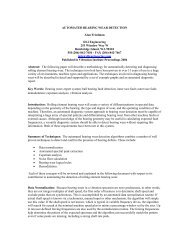Pg 1 / 5 CONTACT: Moses Tan: zentan@singnet.com.sg TITLE ...
Pg 1 / 5 CONTACT: Moses Tan: zentan@singnet.com.sg TITLE ...
Pg 1 / 5 CONTACT: Moses Tan: zentan@singnet.com.sg TITLE ...
You also want an ePaper? Increase the reach of your titles
YUMPU automatically turns print PDFs into web optimized ePapers that Google loves.
<strong>TITLE</strong>: LEAN MANUFACTURING TRAINING AND CONSULTING USING COSTS TODRIVE AND MEASURE CONTINUOUS IMPROVEMENT PROJECTS.PROPOSITION:LEAN Manufacturing Training and Consulting Programs which use COST indices to planand track Continuous Improvement LEAN Projects is the most effective. Here’s the whysand hows.Abstract:“Using measurements to drive and sustain quality performance improvesthe probability of achieving the organization’s strategic objectives”- Yale School of ManagementManufacturers worldwide today face tremendous pressures brought about byincreasing <strong>com</strong>petition. The steady erosion of selling prices and shrinkingprofit margins force manufacturers to continuously seek to cut costs andwastes so as to achieve lower and still lower manufacturing costs.Saving on labor costs is one of the most obvious ways to reduce overallProduct costs. And so is out-sourcing. But as these practices be<strong>com</strong>e thestandard operational mode, the ground is leveled again and manufacturersturn to the other two battlegrounds for determining the survival of the fittest- Creativity and LEAN.LEAN Manufacturing has been defined as the sum total of JIT (Just-In-Time),Kanban (Pull system), Kai’zen (Continuous Improvement), Zero Defects, ZeroBreakdowns, Zero accidents and Zero inventoriesTABLE OF CONTENTS:1. Cost Elements in Manufacturing.2. Challenges of Planning LEAN Projects.3. How The LEAN ScoreBoard Can Help Manufacturers.<strong>Pg</strong> 1 / 5<strong>CONTACT</strong>: <strong>Moses</strong> <strong>Tan</strong>: <strong>zentan@singnet</strong>.<strong>com</strong>.<strong>sg</strong>
1. Cost Elements In Manufacturing.The cost structure of each WIP in each Process and cost of the Final Product ycan be represented as follows:Labor Costs andPerformanceInefficiencies.$$Equipment Costsand PerformanceInefficienciesEnergy Costs andUsage Inefficiencies$Production OverheadCosts$$ $$Material Costs andUsage InefficienciesFactory Overhead CostsEach of these ‘Six Cost Elements’ have both Technical / Operational Measurements as well astheir equivalent Cost Measurements. For example, it is possible to calculate the Cost of theTechnical / Operational indices and produce the following relationships in the TABLE for boththe Final Product as well as a WIP at any process. As each Product is manufactured over multipleprocesses, any WIP losses incurred in a mid-process also incurs the value-added lossesaccumulated over the <strong>com</strong>pleted processes.Cost Of Each WIP(Example Only)Each$6.74Remarks On The Equivalent Technicalor Operational Indices.Preceding Stage Cost $5.07 Valued added costs of previous process stages.Direct Labor Costs $0.20 Operators, Inspectors, Technicians, SupervisorsDirect Production $0.13 Electricity, Gas energy used in the Process and machines.ExpensesProduction Material $0.04 Damaged, expired, wasted, spilled, remnants.LossesProduction Material Costs $0.30 Actual cost of material used per piece of WIP.Machine PerformanceLosses$0.14 Slowed speed, frequent breakdowns and setup times and jams inautomated systems resulting in less output produced.Process Yield Losses $0.18 Scrapped due to failed quality standards.Production OverheadCosts$0.35 Depreciation, Repairs & Maintenance, indirect staff, floor spacerental, property taxes, indirect production materials, etc…Factory Overhead Costs $0.33 Overhead costs incurred by the support, administrative andmanagement staffs.<strong>Pg</strong> 2 / 5<strong>CONTACT</strong>: <strong>Moses</strong> <strong>Tan</strong>: <strong>zentan@singnet</strong>.<strong>com</strong>.<strong>sg</strong>
2. Challenges Of Planning LEAN Manufacturing.In a typical scenario, the Managing Director of Manufacturer XZ announced to his staff that theirTotal Product Cost has to go down 8% per year for the next 3 years in order to maintain theirProfit Margin in view of the project erosion of Selling Price. He asked for all his DepartmentalHeads to submit plans so that the Company can achieve this 8% cost-reduction goal.The MD’s request was met with a muted response as none of his Department Heads are able to bevery specific about cost-reduction initiatives except for perhaps, reduction in headcounts, budgetscuts on Repair and Maintenance where the costs are already measurement in dollars.On the other hand, many important technical / operational cost-reduction initiatives such as thoselisted below have no easy convertibility to COST. Reducing the scrap by improving the Process Yield %, Increasing the machine uptime by reducing breakdowns, setups, jams, etc… Reducing the material wastages in the Production processes. Improving efficiency of energy consumption in certain processes Improving the process flow and reducing the cycle time.As a result, LEAN Projects planning are seldom specific enough in terms of meeting budgetgoals. They often continued to be expressed only in their relevant technical / operationalmeasures. Their eventual impact on the cost-reduction goal is also seldom verifiable.Especially in mature industries, <strong>com</strong>petition tends to be extremely keen and over the years, theobvious or so-called, low-hanging fruits are all but exhausted. Manufacturers run out of ideas forimprovements to achieve further cost reductions. The use of the LEAN ScoreBoard will enablemanufacturers to ferret out the higher-hanging fruits that are usually not obvious otherwise.3. How The LEAN ScoreBoard Measures LEAN.The LEAN ScoreBoard is a software solution for Lean Manufacturing Planning.Existing Enterprise Resource Planning (ERP) and Manufacturing Resource Planning(MRP) solutions provide manufacturers with effective and efficient integration ofFinance and other business processes with Production Scheduling and InventoryControl. The LEAN ScoreBoard is a CiP (Continuous Improvement Planning) Softwarewhich provide Manufacturers with enhanced ability to plan effective cost-reductionimprovement projects to achieve LEAN manufacturingThe LEAN ScoreBoard can be used by ANY manufacturer for enterprise-levelContinuous Improvement project planning for Product Cost-reduction.It breakdowns the Total Product cost into equivalent process-level cost details inrelation to technical + operational data such as – a) Machine performance b)Material usage c) Overheads d) Energy consumption e) Labor inefficiencies.<strong>Pg</strong> 3 / 5<strong>CONTACT</strong>: <strong>Moses</strong> <strong>Tan</strong>: <strong>zentan@singnet</strong>.<strong>com</strong>.<strong>sg</strong>
The LEAN ScoreBoard takes input information that is <strong>com</strong>monly available from theAccounting and Operation Departments. Though some customization of INPUTs isrequired across different industry-types and the Process Engine Software is generic.It is web-based to provide everyone in the enterprise (Top Management, Managers,Executives and Engineers) access to accurate product cost information that isrelated to detailed Process-level technical and operational information. Thispromotes organizational alignment to achieve the LEAN organization.The LEAN ScoreBoard works in 3 steps. In Step 1, a standard set of <strong>com</strong>monlyavailable Selling Price, Profit Margin %, Accounting and Operational data is keyedinto a user-friendly customized Input-interface screen.In Step-2, the LEAN ScoreBoard process engine digests the input data to produceinformative reports at enterprise and individual process levels. These reports relatecost / technical / operational indices together at each process. This provideManagers, executives and engineers with critical information for detailed andmeaningful planning which includesa) Selection of significant improvement-projects to achieve the cost-reductiongoal.b) Identifying Key Improvement Concepts for each selected project.c) Quantifying the amount of improvement target (technical or operationalindices) for each selected project and the expected cost-reduction potential.The cost-reduction impact on process cost and overall product cost can be simulatedby inputting these improvement targets into the LEAN ScoreBoard.The LEAN ScoreBoard operates in real-time. As each month’s data from Accounting,Operations and Project Team are entered, the LEAN ScoreBoard publishes updatedcurrent-month status of costs / operational / technical / project team’s status in anintegrated and related manner.FOR MORE INFORMATION:Please email to < <strong>zentan@singnet</strong>.<strong>com</strong>.<strong>sg</strong> > or call <strong>Moses</strong> <strong>Tan</strong>, the author &LEAN ScoreBoard Developer, at +65.97273525<strong>Pg</strong> 4 / 5<strong>CONTACT</strong>: <strong>Moses</strong> <strong>Tan</strong>: <strong>zentan@singnet</strong>.<strong>com</strong>.<strong>sg</strong>
LEAN MANAGEMENT SOLUTIONSZenPower International10 Anson Rd,#16-16 International Plaza, Singapore.www.tpmquality.<strong>com</strong>www.leanscoreboardemail: <strong>zentan@singnet</strong>.<strong>com</strong>.<strong>sg</strong>Tel contact: +65.97273525The LEAN ScoreBoard SolutionWhite Paper October 2006<strong>Pg</strong> 5 / 5<strong>CONTACT</strong>: <strong>Moses</strong> <strong>Tan</strong>: <strong>zentan@singnet</strong>.<strong>com</strong>.<strong>sg</strong>


